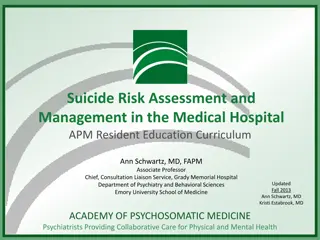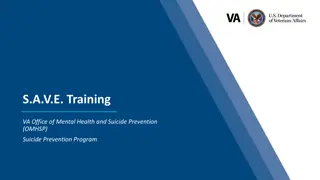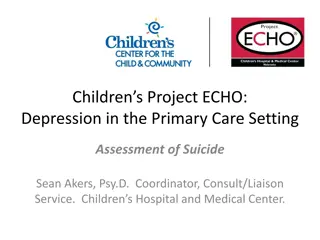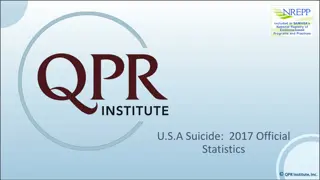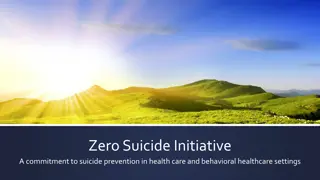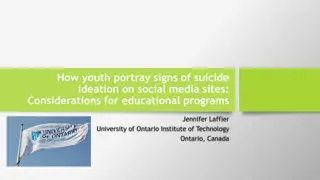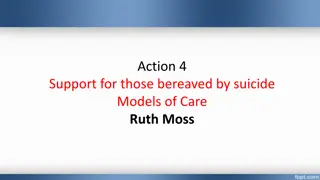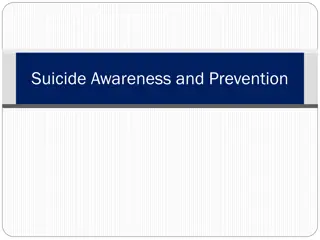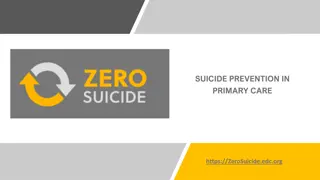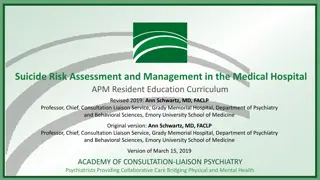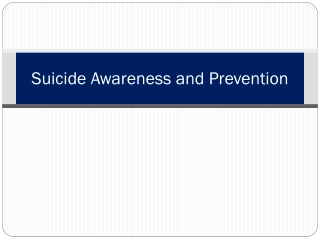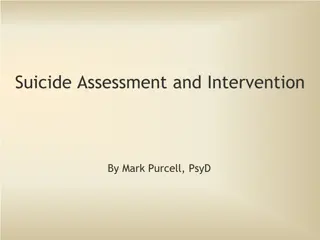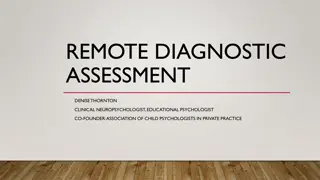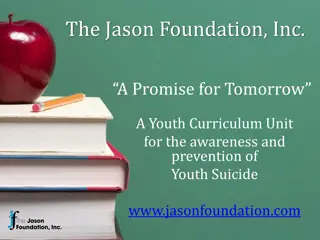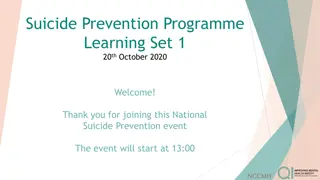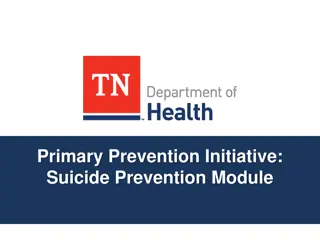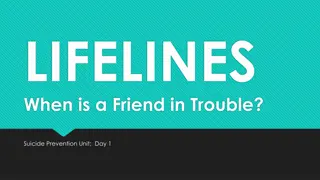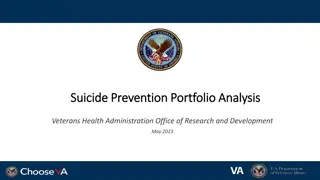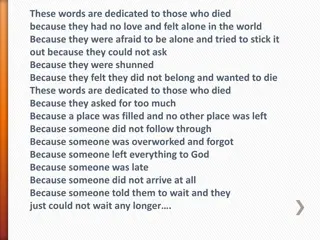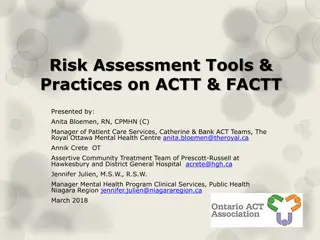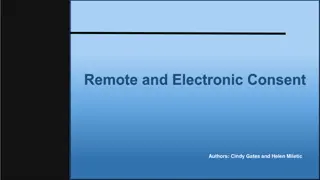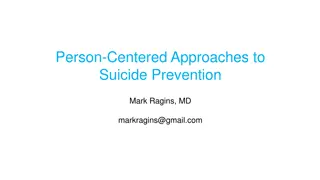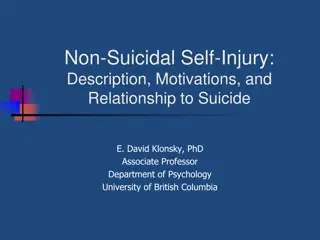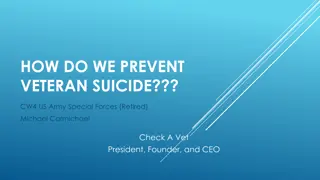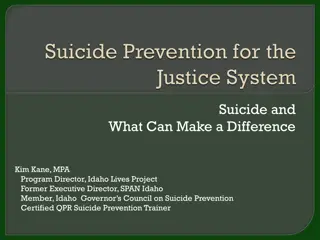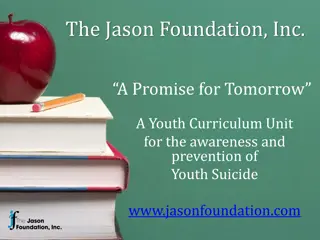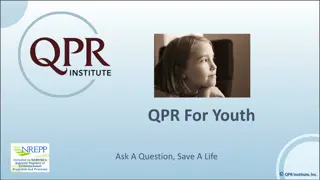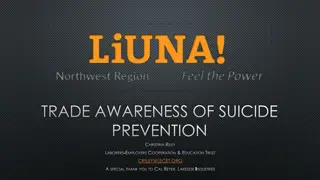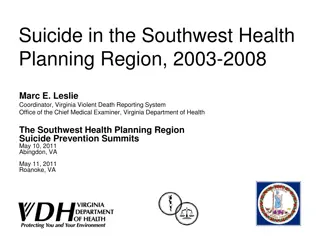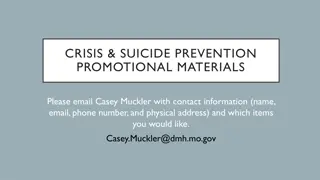Suicide Risk Assessment Best Practices in Remote Work Settings
Challenges in conducting suicide risk assessments in remote work environments include reduced access to in-person clinician support, reliance on technology for crisis interventions, and the impact of home isolation on team debriefing. Guidelines for when to conduct risk assessments, reminders on protocol adherence, notifying on-call clinicians, and the importance of identifying a participant's physical location are essential for maintaining safety and efficacy in remote mental health practice.
Download Presentation

Please find below an Image/Link to download the presentation.
The content on the website is provided AS IS for your information and personal use only. It may not be sold, licensed, or shared on other websites without obtaining consent from the author. Download presentation by click this link. If you encounter any issues during the download, it is possible that the publisher has removed the file from their server.
E N D
Presentation Transcript
Suicide Risk Assessments Notes and Practice
Challenges with remote work Reduced access to in-person clinician support (e.g, going down the hall to flag down a clinician) Technology oUtilizing cell phones to 3-way call to crisis line, connect with clinicians, etc. oRisk of dropped calls, poor connections, etc. Home isolation missing out on the ability to debrief with team members after a tough call/assessment
When do we conduct risk assessments? In response to flag from an online assessment oParticipant endorses a risk item on an online assessment oIn these cases, we have time to prepare and contact the on-call clinician in advance In the process of a phone or video-based assessment or therapy session oBecause a participant endorses a risk measure, or oThe participant mentions a desire to end their life or a lack of hope, etc. in context of the assessment or therapy session In the process of an in-person assessment or therapy session (currently not a possibility)
Reminders about risk assessments Every study has a protocol and a flow chart to help you guide you It is important to follow the flowchart in order as much as possible to formulate the clearest picture of risk level It is our role as researchers to ensure that participants are directed to resources (e.g., crisis line, providers, emergency help) that will help keep them safe In a risk situation, it IS our responsibility to gather information to judge current risk level. It IS NOT our responsibility to provide therapy, develop safety plans or make decisions about treatment. A clinician may ask you to be involved in actively reducing means (e.g., remove weapons or medications) or ensure immediate safety). It is the responsibility of the on-call clinician to make decisions about breaking confidentiality, if necessary, to keep a participant safe. Clinicians do not feel burdened by you when you call/text
Notifying on-call clinician We will be proactive about letting the clinician know when we will be conducting assessments If the on-call clinician does not respond back to your text with an affirmative within 15 minutes, you know that you will need to contact the backup clinician if you encounter a high-risk situation that warrants reaching out to a clinician Every study will have a designated back-up Make sure clinicians have your work and personal cell phone numbers
Identifying physical location of participant Prior to conducting any assessment or therapy session, we will confirm the participant s exact location We will notify participants during recruitment that this will be our process, so that they are not surprised when we ask them at each assessment (each study will talk about what this process looks like) Hold onto location information for duration of the phone call, then destroy What this sounds like: Before we begin, I want to just make sure that I am able to help keep you safe in the case of an emergency. Would you be willing to share your address or location with me in the case that we become disconnected or if I need to get help to you for any reason? If participant says no, then we suggest that we will call back at a different time ROLE PLAY Scenario 1 participant provides location Scenario 2 participant refuses to provide location
Handling of high-risk cases If participant is in acute imminent risk and you feel that they cannot keep themselves safe during the phone call, call 911 If participant is high risk, follow these steps: 1) Acknowledge your concern and that you will need to take some steps to ensure that the participant is safe 2) recommend that you connect the participant to the Suicide Prevention Lifeline/Veterans Crisis Line as a first option This does not require clinician approval and can be done as an immediate step once you determine high risk Can also be done for moderate cases 3) If participant is NOT willing to call the crisis lifeline, the next option you give them is to call the study on-call clinician to talk them through some options 4) From here the on-call clinician will help you talk the participant through options to get them to safety Taking self to ED Getting friend or family member to take to ED Calling provider Calling EMT/police ROLE PLAY Scenario 1 participant willing to call lifeline Scenario 2 participant is not willing to call lifeline
Calling emergency services Calling 911 oWhen participant is in immediate harm oMay be done based on RA discretion without clinician if participant has means and is expressing intent to act on those means in the immediate future (e.g., within the next hour) oWhen calling 911: Be prepared to provide your name, phone number, and location What problem is o Be very specific about history of relationship with participant, mental health crisis situation, whether or not participant is alone, previous hospitalizations, medications, diagnoses, etc. Location Specific location of participant, if you don t have specific location you can also share home address (whether or not participant is there), other places where the participant spends time, family member locations etc. This is also where you provide city location so dispatch knows where to go Description of person If you have met them, otherwise, we can take basic demographic information from surveys (age, race, sex/gender) Weapons or threat of weapons (including items that could be used as weapons) Any violent history, especially toward authority Direct or indirect threat to hurt themselves or others Substance use if relevant oDispatch may call you back and ask for more information or to follow-up with you
Calling emergency services Calling non-emergency numbers for a welfare check oIf participant hangs up on you or is otherwise not able or willing to cooperate oIn collaboration with on-call clinician oBe prepared to share similar information as in previous slide
Other helpful remote procedures Print out the flow chart and other phone numbers and have them readily available The importance of role plays and testing the technology Consider using an internet line (e.g., Jabber) to connect to Crisis Line while on the phone with participant
Breakout sessions Small groups Considering the changes we outlined today, what questions/concerns do you have? Notifying clinicians Getting ahold of clinicians Identifying participant location Connecting participants to lifeline in high risk situations



